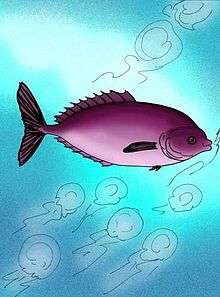Luvaris necopinatus
| Luvaris necopinatus Temporal range: 59–56 Ma | |
|---|---|
 | |
| Artist's reconstruction | |
| Scientific classification | |
| Kingdom: | Animalia |
| Phylum: | Chordata |
| Class: | Actinopterygii |
| Order: | Perciformes |
| Suborder: | Acanthuroidei |
| Family: | Luvaridae |
| Genus: | Luvaris |
| Species: | L. necopinatus |
| Synonyms | |
| |
Luvaris necopinatus is a species of extinct louvar that lived in the Tethys Ocean during the early Paleogene. It differs from the modern species, L. imperialis, in that L. necopinatus has an oval body shape, and is around one foot in length when fully grown.
The first specimens were found from the Danata Formation Lagerstätten, of the Thanetian to Ypresian epochs of Turkmenistan. L. necopinatus was originally described as "Proluvarus necopinatus," [1] citing several anatomical differences between Proluvarus and Luvaris. A later reexamination of the fossil specimens lead researchers to reappraise Proluvarus as a junior synonym, as well as determine that specimens of what were originally thought to be juveniles were actually two different species of a different genus of louvar, Avitoluvarus.[2]
References
- ↑ Morphology of Luvaris imperialis (Luvaridae), with a Phylogenetic Analysis of the Acanthuroidei (Pisces)
- ↑ Phylogenetic Revision of the Fish Families Luvaridae and †Kushlukiidae (Acanthuroidei), with a New Genus and Two New Species of Eocene Luvarids